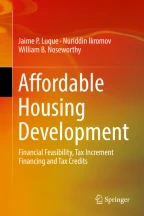Financial Feasibility Analysis: Planning for the Possible

In this chapter, we discuss the concept of financial feasibility introduced by the late James Graaskamp. We also review two commonly used techniques in feasibility studies, the front-door analysis, and the back-door analysis. These concepts and techniques will be used in subsequent chapters to assess the impact of location and financial subsidies, such as Low Income Housing Tax Credits and Tax Increment Financing, on the feasibility of an affordable housing development project.
This is a preview of subscription content, log in via an institution to check access.
Access this chapter
Subscribe and save
Springer+ Basic
€32.70 /Month
- Get 10 units per month
- Download Article/Chapter or eBook
- 1 Unit = 1 Article or 1 Chapter
- Cancel anytime
Buy Now
Price includes VAT (France)
eBook EUR 74.89 Price includes VAT (France)
Hardcover Book EUR 94.94 Price includes VAT (France)
Tax calculation will be finalised at checkout
Purchases are for personal use only
Notes
Annual loan constant is defined as the annual payment required to amortize (pay off) $1 of debt, and it depends on the term and interest rate of the loan.
Debt coverage ratio is defined as: net operating income divided by annual debt service. Depending on the type of project, lenders require the debt coverage ratio to be at least 1.15–1.25, meaning the net operating income must be 15–25% more than the annual debt service.
References
- Ciochetti BA, Malizia E (2000) The application of financial analysis and market research to the real estate development process. In: DeLisle JR et al (eds) Essays in honor of James a. Graaskamp: ten years after. Springer, Boston, MA, pp 135–163 ChapterGoogle Scholar
- DeLisle J, Griego R (2008) Frontdoor/backdoor analysis. Case study. The University of Washington Google Scholar
- Graaskamp JA (1972) A rational approach to feasibility analysis. Apprais J 40(October):513–521 Google Scholar
- Graaskamp JA (1981) Fundamentals of real estate development. The Urban Land Institute, Washington, DC Google Scholar
- Malpezzi S (2015) The Wisconsin program in real estate and urban land economics: a century of tradition and innovation. University of Wisconsin, Madison, WI Google Scholar
Author information
Authors and Affiliations
- ESCP Europe, Madrid, Spain Jaime P. Luque
- California State University, Sacramento, CA, USA Nuriddin Ikromov
- McNeese State University, Lake Charles, LA, USA William B. Noseworthy
- Jaime P. Luque

